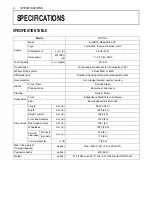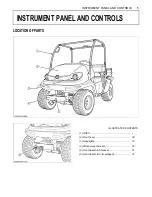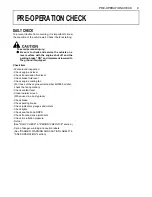
SAFE OPERATION
4
Before servicing the vehicle, park it on a firm, flat and level
surface, set the parking brake, lower all implements to the
ground, place the range gear shift lever in neutral, stop the
engine and remove the key.
1. Allow the vehicle time to cool off before working on or
near the engine, muffler, radiator, etc.
2. Always stop the engine before refueling. Avoid spills
and overfilling.
3. Do not smoke when working around battery or when
refueling. Keep all sparks and flames away from
battery and fuel tank. The battery presents an
explosive hazard, because it gives off hydrogen and
oxygen especially when recharging.
4. Before "jump starting" a dead battery, read and follow
all of the instructions. (See "JUMP STARTING" in
"OPERATING THE ENGINE" section.)
5. Keep first aid kit and fire extinguisher handy at all
times.
6. Disconnect the battery's ground cable before working
on or near electric components.
7. To avoid the possibility of battery explosion, do not use
or charge the refillable type battery if the fluid level is
below the LOWER (lower limit level) mark. Check the
fluid level regularly and add distilled water as required
so that the fluid level is between the UPPER and
LOWER marks.
8. To avoid sparks from an accidental short circuit,
always disconnect the battery's ground cable (-) first
and reconnect it last.
9. Do not remove radiator cap while coolant is hot. When
cool, slowly rotate cap to the first stop and allow
sufficient time for excess pressure to escape before
removing the cap completely. If the vehicle has a
coolant recovery tank, add coolant or water to the tank,
not the radiator. (See "Checking Coolant Level" in
"DAILY CHECK" in "PERIODIC SERVICE" section.)
10.Do not attempt to mount a tire on a rim. This should be
done by a qualified person with the proper equipment.
11. Always maintain the correct tire pressure. Do not
inflate tires above the recommended pressure shown
in the operator's manual.
12. Securely support the vehicle when changing wheels.
13. Make sure that wheel bolts have been tightened to the
specified torque.
14. Do not work under any hydraulically supported
devices. They can settle, suddenly leak down, or be
accidentally lowered. If it is necessary to work under
the vehicle or any vehicle elements for servicing or
adjustment, securely support them with stands or
suitable blocking beforehand.
15. Escaping hydraulic fluid under pressure has sufficient
force to penetrate skin causing serious personal injury.
Before disconnecting hydraulic lines, be sure to
release all residual pressure. Before applying
pressure to the hydraulic system, make sure that all
connections are tight and that all lines, pipes, and
hoses are free of damage.
"High pressure fluid - Injection into body" hazard
warning.
16. Fluid escaping from pinholes may be invisible. Do not
use hands to search for suspected leaks; use a piece
of cardboard or wood. Use of safety goggles or other
eye protection is also highly recommended. If injured
by escaping fluid, see a medical doctor at once. This
fluid will produce gangrene or severe allergic reaction.
6. SERVICING THE VEHICLE
(1) Battery
Содержание RTV500
Страница 13: ...5 SAFE OPERATION 1 Cardboard 2 Hydraulic line 3 Magnifying glass...
Страница 14: ...SAFE OPERATION 6 7 DANGER WARNING AND CAUTION LABELS...
Страница 15: ...7 SAFE OPERATION...
Страница 16: ...SAFE OPERATION 8...
Страница 18: ......













































